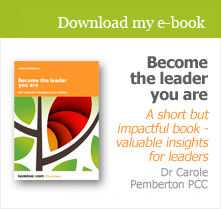Clinging - and pausing
Earlier this year I had the opportunity of participating in a mindfulness meditation retreat themed ‘Finding the Way Home’ (I mentioned it briefly in my blog on ‘Home: what does it mean for the leader?’ ). It would be easy to see the retreat as a self-contained, stand-alone few days in a beautiful countryside location, but I’m struck that, two months later, not only do I still seem to be feeling its impact and benefits, but also that the impact extends to some ways in which I relate to those around me.
In that blog on ‘home’ I mentioned stability and acceptance, but it goes further than that. The pause offered by the retreat was a stepping back from the usual busy routine and a chance to simply be in the world, rather than get caught up in the constant doing. My experience has a certain amount to offer to the leaders I coach.
Besides the meditation sessions as such, the retreat offered talks and Q and A sessions facilitated by the retreat leaders. As time has gone on, I’m realising more and more how my experiences of the different sessions permeated each other – and particularly how the learning from those sessions now permeates my outlook on the world and my place in it. Exponentially I discovered a new outlook on boundaries and separation.
Foregrounding
Foregrounding was raised as a theme in one of the talks. That prompted my reflection on what I choose to pay attention to – what I position in my foreground (in Gestalt terms, what my ‘figure’ is at any given moment). And increasingly, as the time went on, I became more and more aware of the choices I was making about what I was choosing to pay attention to (and what I was choosing – consciously or unconsciously) to set aside – and in the process, what I might be failing to take account of.
Clinging
This related to the talk that really caught my attention: a talk on clinging, grippiness and tightening. We were invited to reflect on what we were clinging on to – ideas, assumptions, beliefs, habits, behaviours…. When we cling, and hold on to things tightly, we become not only rigid but also separated and divided off from others: connection, versatility and flexibility disappear, and their place is taken by tightness in the body (we feel muscle tension and rigidity in the way we hold ourselves, knowingly and unknowingly) and in the mind: it shows in our posture, the way we breathe, the way we speak and our gestures – and in our rigidity (or even stubbornness) in holding on to ideas we’re used to, have persuaded ourselves of, or are even too fearful to let go of.
Softening
The way through or past clinging, it was suggested, was softening: if we don’t cling, we don’t create any division. It seems to me that compassion then comes more easily, that our perspectives are broader, our capacity to engage with differing views enlarges, and our openness to learning and therefore to development expands, and we are able to appreciate and engage with wider horizons. It occurs to me too that stress can fall away in such circumstances, and that in the resulting calm we can therefore engage more fully with possibilities without translating them into the pressures that inhibit us. ‘Letting be’ means we don’t push things away, but rather we face into them and even welcome them. Softening and allowing the feelings that arise is a kind of self-compassion, a self-kindness – and we all need some of that!


